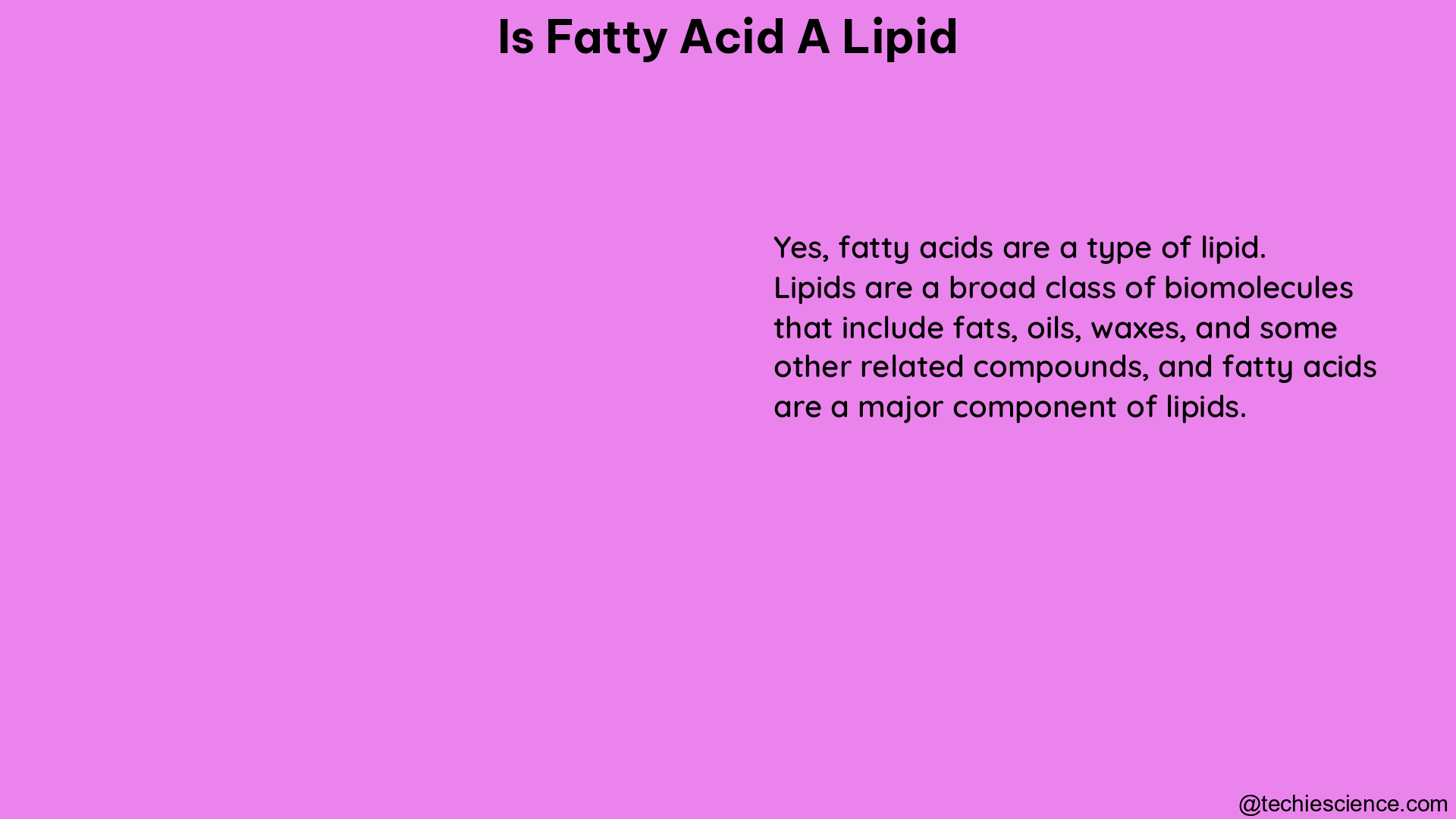Fatty acids are a crucial component of lipids, a diverse class of biomolecules that play vital roles in various biological processes. Understanding the relationship between fatty acids and lipids is essential for understanding the complex biochemistry of living organisms. In this comprehensive guide, we will delve into the intricacies of fatty acids, their classification, and their role as lipids, providing a valuable resource for biology students and researchers.
What are Fatty Acids?
Fatty acids are carboxylic acid compounds consisting of long hydrocarbon chains with a terminal carboxyl group (-COOH). These molecules can vary in length, ranging from short-chain fatty acids (4-6 carbon atoms) to long-chain fatty acids (18-24 carbon atoms). Fatty acids can be saturated, meaning they have no double bonds between carbon atoms, or unsaturated, containing one or more double bonds.
Classification of Fatty Acids
Fatty acids can be classified based on several criteria, including:
- Chain Length:
- Short-chain fatty acids (4-6 carbon atoms)
- Medium-chain fatty acids (8-12 carbon atoms)
- Long-chain fatty acids (14-20 carbon atoms)
-
Very long-chain fatty acids (22-24 carbon atoms)
-
Degree of Saturation:
- Saturated fatty acids (no double bonds)
- Monounsaturated fatty acids (one double bond)
-
Polyunsaturated fatty acids (two or more double bonds)
-
Omega (ω) Designation:
- Omega-3 fatty acids (double bond at the third carbon from the methyl end)
- Omega-6 fatty acids (double bond at the sixth carbon from the methyl end)
- Omega-9 fatty acids (double bond at the ninth carbon from the methyl end)
Fatty Acids as Lipids
Fatty acids are a type of lipid, a broad class of biomolecules that includes fats, waxes, sterols, fat-soluble vitamins, and other related compounds. Lipids are characterized by their hydrophobic nature, meaning they are insoluble in water but soluble in non-polar solvents.
Fatty acids can be found in various lipid classes, including:
- Neutral Lipids:
- Triglycerides (triacylglycerols)
- Diacylglycerols
-
Monoacylglycerols
-
Phospholipids:
- Phosphatidylcholine (lecithin)
- Phosphatidylethanolamine
- Phosphatidylserine
-
Phosphatidylinositol
-
Glycolipids:
- Cerebrosides
-
Gangliosides
-
Sterols:
- Cholesterol
- Phytosterols (plant sterols)
Fatty acids are typically present in esterified form as components of these lipid classes, where the carboxyl group of the fatty acid is linked to other molecules, such as glycerol or cholesterol. This esterification process is crucial for the structural and functional properties of lipids.
Quantification of Fatty Acids

Fatty acids can be quantified using various analytical techniques, such as gas chromatography-mass spectrometry (GC-MS) and liquid chromatography-mass spectrometry (LC-MS). One of the preferred methods for measuring total fatty acid content is acid-catalyzed transesterification.
Acid-Catalyzed Transesterification
The acid-catalyzed transesterification process involves the following steps:
- Solubilization and Hydrolysis:
- The lipids in the sample are solubilized, and the esterified fatty acids are hydrolyzed by the addition of an acid catalyst, such as sulfuric acid or hydrochloric acid.
-
This step simultaneously solubilizes the lipids and frees the fatty acids.
-
Methylation:
- A methyl group from methanol is transferred onto the acyl chains of the lipids, producing methyl esters of the fatty acids (FAME).
-
This process is known as methylation or transesterification.
-
Extraction and Purification:
- The FAME are extracted from the polar methanol phase using a non-polar solvent, such as hexane.
-
This step separates the FAME from the polar compounds, such as glycerol or phosphatidic acid.
-
Quantification:
- An internal standard, typically an odd-chain fatty acid (e.g., C13:0ME) that does not naturally occur in the sample, is added and transesterified along with the sample.
- The FAME, including the internal standard, are then quantified using a gas chromatograph.
- The total FAME content is calculated based on the response of the internal standard.
This acid-catalyzed transesterification method is widely used to measure the total fatty acid content in various biological samples, such as plant oils, animal fats, and microbial lipids.
Importance of Fatty Acids as Lipids
Fatty acids, as components of lipids, play crucial roles in various biological processes:
-
Energy Storage: Triglycerides, the primary storage form of fatty acids, provide a dense and efficient source of energy for the body.
-
Membrane Structure: Phospholipids, which contain fatty acids, are the primary structural components of cell membranes, ensuring the integrity and permeability of cells.
-
Signaling Molecules: Certain fatty acids, such as arachidonic acid and eicosapentaenoic acid (EPA), can be converted into eicosanoids, which act as signaling molecules involved in inflammation, immune response, and other physiological processes.
-
Vitamin Transport: Fat-soluble vitamins, such as vitamins A, D, E, and K, require fatty acids for their absorption, transport, and storage in the body.
-
Insulation and Protection: Fatty acids, in the form of waxes and adipose tissue, provide insulation and physical protection for the body.
-
Hormone Synthesis: Fatty acids are precursors for the synthesis of steroid hormones, such as testosterone, estrogen, and cortisol.
Understanding the role of fatty acids as lipids is crucial for various fields, including nutrition, medicine, and biotechnology, where the manipulation and optimization of lipid metabolism can have significant implications.
Conclusion
In summary, fatty acids are a type of lipid that play a vital role in the structure and function of living organisms. Their classification, quantification, and importance as lipids provide a comprehensive understanding of their significance in biological systems. This knowledge is essential for researchers, students, and professionals working in the fields of biochemistry, nutrition, and biotechnology.
References:
- Quantification of Lipids: Model, Reality, and Compromise – NCBI. Available at: https://www.ncbi.nlm.nih.gov/pmc/articles/PMC6316828/
- Analytical Methods to Quantify Free Fatty Acids – Creative Proteomics. Available at: https://lipidomics.creative-proteomics.com/resource/analytical-methods-to-quantify-free-fatty-acids.htm
- Determination of Total Lipids as Fatty Acid Methyl Esters – NREL. Available at: https://www.nrel.gov/docs/fy24osti/87501.pdf
- Determination of Total Lipids as Fatty Acid Methyl Esters (FAME) by … Available at: https://www.nrel.gov/docs/fy16osti/60958.pdf
- Quantitative Bioanalytical Methods: Critical for Interpretation of Results. Available at: https://www.ncbi.nlm.nih.gov/pmc/articles/PMC6316828/
- Validation Procedures and Acceptance Criteria for Quantitative Bioanalytical Methods. Available at: https://www.ncbi.nlm.nih.gov/pmc/articles/PMC6316828/

Hello, I am Bhairavi Rathod, I have completed my Master’s in Biotechnology and qualified ICAR NET 2021 in Agricultural Biotechnology. My area of specialization is Integrated Biotechnology. I have the experience to teach and write very complex things in a simple way for learners.